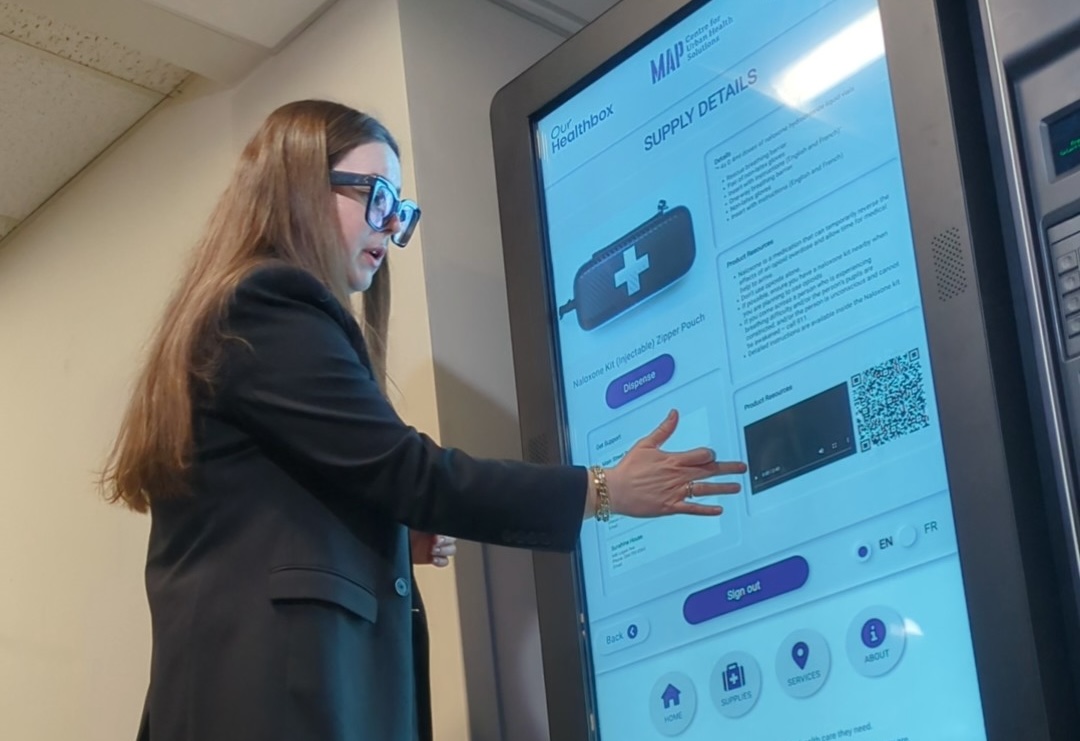St. Boniface Hospital is proud to be the first Canadian acute care facility to introduce a harm reduction kiosk that dispenses free supplies without judgement or onerous administration. The large box, which looks and functions like a vending machine, will soon find a permanent home in the new Emergency Department, and features items such as naloxone injection kits, clean needles, first aid kits, safer sex supplies and menstruation products.
For Katarina Lee-Ameduri, the Director of Ethics for Réseau Compassion Network, and Clinical Ethicist at St. Boniface Hospital, this kiosk is about offering the best care possible to anyone who needs it, whether they are living unhoused, struggling with addiction or facing mental health issues. “Harm reduction is first and foremost about trying to mitigate or avoid secondary impacts,” she explains. “Maybe abstinence from substances would be helpful for someone, but if they’re not ready for that yet, let’s help them avoid getting HIV or any other transmissible diseases, at the very least. Until they get to the point of stopping substance use, we don’t want them to get sicker.”
She also stresses that harm reduction is a compassionate response for the people who are facing mental health and addictions challenges. “Most of all, we want people to have positive experiences as they navigate their journey,” Lee-Ameduri says. “We take for granted things like brushing our teeth or having something to eat when we’re hungry. But this is about providing dignity to people who are seeking only to be clean, safe and comfortable. I sometimes think we’re all a few steps away from being unhoused. Sometimes all it takes is a relationship breakdown, to lose your job or to get ill.”
Lee-Ameduri admits there is misinformation and fear around harm reduction, something she hopes the kiosk will help combat. “For example, wearing a seat belt is a form of harm reduction,” she explains. “People judge a kiosk like this because it’s for people who use drugs, but we don’t think twice about the seatbelt. Everyone deserves safety.”
The connection between harm reduction and acute care is a natural fit, according to the ethicist. “We had and still have a lot of patients with endocarditis, which is an infection that causes someone to need a new valve in their heart,” Lee-Ameduri explains. “People who use substances with needles are at increased risk. They’re also at increased risk for cellulitis, which is a skin infection also associated with drug use. We made sure to cater our supplies to our local population and with an eye to decreasing these types of complications.”
While the hospital can identify populations that need supports, they’re aware that the supports need to be offered in the right way to truly make an impact. “I hope people using the kiosk feel recognized, that they know there are people who see them and are trying to help in ways that allow them to have dignity,” reflects Lee-Ameduri. “They don’t have to ask permission to use the kiosk, they don’t have to talk to anyone at all if they don’t want to. And it helps our entire community understand that there are unmet needs among us. Maybe this will empower people to talk about this in their social groups and workplaces. I hope we can build more support for these types of initiatives.”
Speaking of support, Lee-Ameduri is grateful for all the people and organizations who supported and worked behind the scenes to make this kiosk possible, from project partners myHealthbox, CANFAR and BMO, to the hospital staff who moved the box, sorted out electrical and ethernet requirements, and the staff who will stock and manage the kiosk. “There were a lot of small details that were taken care of,” she concludes. “This was years and years in the making and there are so many people to thank. Most of all, St. Boniface Hospital is so happy to be able to offer dignity and safety to those who need it most.”
•••
To learn more about myHealthbox, please click here.

